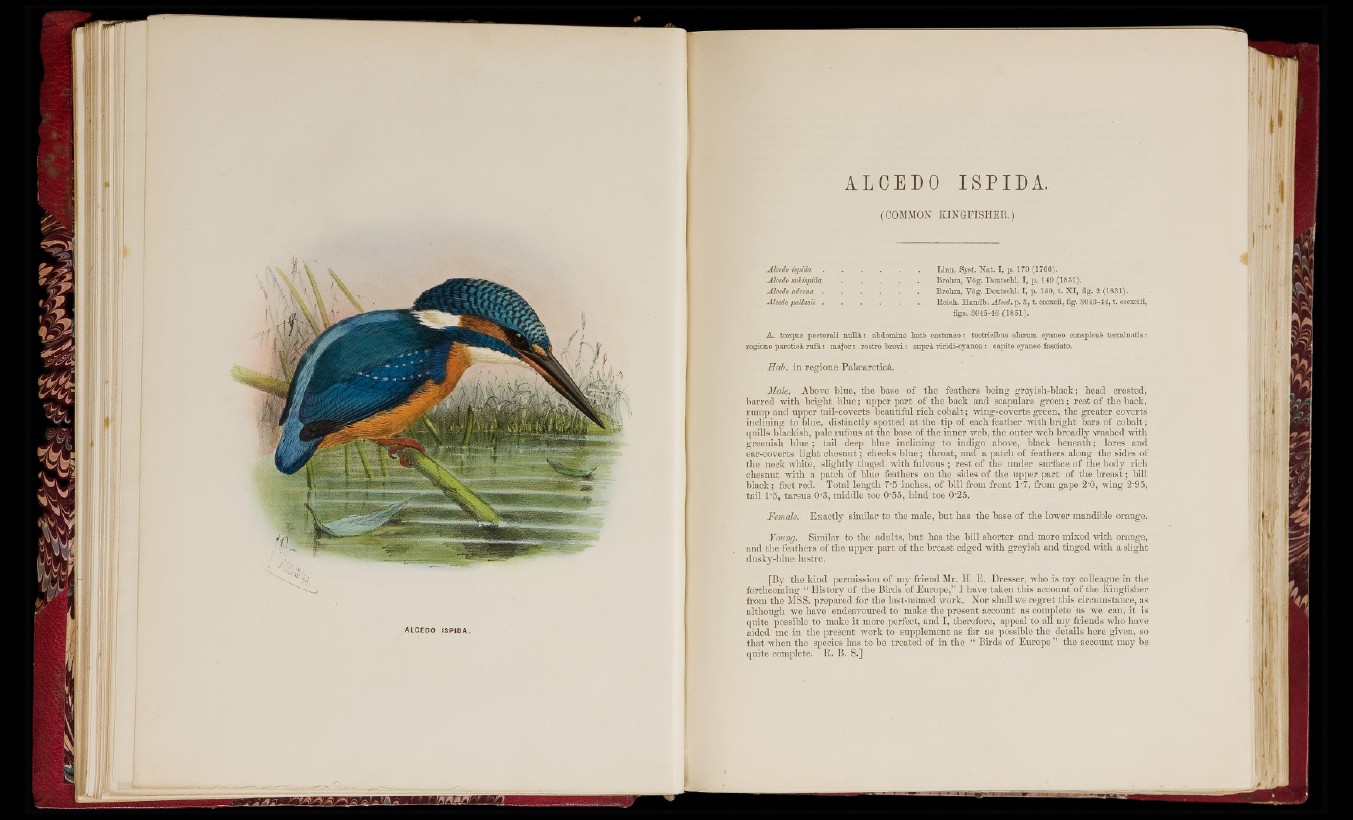
ALCEDO iSPÍD A.
AL CE DO I S P I DA.
(COMMON K IN G F ISH E R .)
Ahedo i s p i d a ........................................................Linn. Syst. Nat. I, p. 179 (1766).
Ahedo s x è i s p i d a .............................................. Brelini, Viig. Deutschl. I, p. 149 (1831).
Ahedo a d v e n a ........................................................Brehm, Yog. Deutscil. I, p. 150, t. XI, fig. 2 (1831),
Ahedo p a lla s ii........................................................Eeieh. Handb. Ahed. p. 3, t. cccseii, fig. 3043-44, t. ccesciii,
figs. 3045-46 (1851).
A. torque pectorali nullà : abdomine lietè castaneo : tectricibus aJanun cyaneo conspicuè terminatis :
regione paroticà laifà : major : rostro brevi : suprà viridi-cyanea : capite cj^aneo fasciato.
Hah. in reg io n e Palasarctìcà.
Male. Above blue, th e base o f th e feathers being gi-eyish-black; head crested,
b a rred with b rig h t blue ; u pper p a rt o f th e back aud scapulars green ; res t o f th e back,
rump and upper tail-coverts beautiful rich co b alt; wing-coverts green, th e g rea te r coverts
inclining to blue, distin c tly spotted a t th e tip o f each feather with b rig h t bai-s of cobalt ;
quills blackish, pale rufous a t the base of th e in n er web, th e o u ter web broadly washed with
g reen ish blue ; tail deep blue in clining to indigo above, black b eneath ; lores and
ear-coverts lig h t chesnut ; cheeks blue ; th ro a t, and a p atch o f feathers along the sides of
th e neck white, slightly tinged with M v o u s ; re s t o f the u n d e r surface o f the body rich
chesnut w ith a p atch o f blue feathers on the sides o f the u pper p a rt o f th e b rea st ; bill
black ; feet red. Total len g th 7A inches, o f b ill from fro n t 1'7, from gape 2-0, wing 2'95,
ta il 1-5, tarsu s 0-3, middle toe 0'55, h ind toe 0-25.
Female. Ex a c tly siniilar to the male, b u t has the base o f th e lower mandible orange.
Young. Similar to the adults, b u t has th e b ill shorter and more m ixed unth orange,
and the feathers o f th e u p p e r pai-t o f the b rea st edged with gveyish and tin g ed with a slig h t
dusky-blue lustre.
[By th e kin d permission of my friend Mr. H. E . Dresser, who is my colleague in tlie
forthcoming “ History o f tbe Bh’ds of E u ro p e,” I have tak en th is account o f th e Kingfisher
from th e MSS. prepared for the last-named work. Nor shall we re g re t this cLrcumstance, as
a lthough we have endeavoured to make the present account as complete as we can, it is
(juite possible to make i t more perfect, and I , therefore, appeal to all my friends who have
aided me in the p resen t work to supplement as far as possible th e d etails h ere given, so
th a t when the species has to be tre a ted o f in th e “ Birds o f Europe ” th e account may be
qu ite complete. R. B. S.]